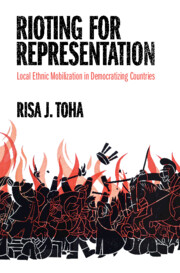Book contents
- Frontmatter
- Dedication
- Contents
- List of Figures
- List of Tables
- Acknowledgements
- 1 Introduction
- 2 Exclusion and Violence during Democratic Transitions
- 3 The Emergence of Identity-Based Cleavages in Indonesia
- 4 Ethnic Politics in Soeharto’s New Order Regime
- 5 Golkar’s Dominance and Ethnic Riots
- 6 Micro Dynamics of Exclusion and Riots
- 7 How Riots Dissipated
- 8 Conclusion
- Appendix A Data Collection Protocol
- Appendix B Additional Tables and Figures
- Glossary
- References
- Index
7 - How Riots Dissipated
Published online by Cambridge University Press: 28 October 2021
- Frontmatter
- Dedication
- Contents
- List of Figures
- List of Tables
- Acknowledgements
- 1 Introduction
- 2 Exclusion and Violence during Democratic Transitions
- 3 The Emergence of Identity-Based Cleavages in Indonesia
- 4 Ethnic Politics in Soeharto’s New Order Regime
- 5 Golkar’s Dominance and Ethnic Riots
- 6 Micro Dynamics of Exclusion and Riots
- 7 How Riots Dissipated
- 8 Conclusion
- Appendix A Data Collection Protocol
- Appendix B Additional Tables and Figures
- Glossary
- References
- Index
Summary
This chapter explains the dissipation of violence. Consistent with my theory, once political exclusion was ameliorated in conflict-ridden districts, the level of violence dropped. The creation of new districts and the implementation of direct elections of local executives accommodated these demands for inclusion. Whereas previously excluded political hopefuls faced impenetrable barriers to election, the creation of new districts multiplied the number of elected positions and increased the likelihood of opposition electoral victories, particularly in post-conflict areas where the electorate was already receptive to ethnic appeals and likely to vote for members of their ethnic group.
Keywords
- Type
- Chapter
- Information
- Rioting for RepresentationLocal Ethnic Mobilization in Democratizing Countries, pp. 199 - 229Publisher: Cambridge University PressPrint publication year: 2021

